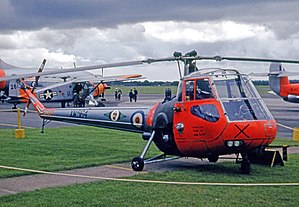| Skeeter | |
|---|---|
 Skeeter AOP.12 of the Central Flying School of the Royal Air Force, 1962 | |
| General information | |
| Type | Trainer, Scout |
| Manufacturer | Saunders-Roe |
| Primary users | British Army |
| Number built | 78 + 10 prototypes |
| History | |
| Introduction date | October 1956 |
| First flight | 10 October 1948 (as Cierva W.14 Skeeter) |
The Saunders-Roe Skeeter is a two-seat training and scout helicopter that was developed and produced by British manufacturer Saunders-Roe ("Saro") of Cowes and Southampton, in the United Kingdom.
Work on what would become the Skeeter had been commenced by the Cierva Autogiro Company as the Cierva W.14. Following Saunders-Roe's takeover of Cierva's helicopter development contracts, it was decided to continue its projects, including the Skeeter. Despite an initial preference for the rival Fairey Ultra-light Helicopter, which had already been ordered, there was a reversal of fortune with interest from the Bundeswehr in the potential procurement of a large number of Skeeters. This led to the British order for the Ultra-light Helicopter being cancelled and the Skeeter effectively taking its place, which also served to guarantee an export order from Germany.
During the late 1950s, the Skeeter entered service with the British Army Air Corps, the German Navy, and the German Army. It has the distinction of being the first helicopter to be used by the Army Air Corps. While some consideration had been made to developing a version of the Skeeter powered by a turbine engine instead of a piston engine, it was decided to produce the developmental Saro P.531 for this purpose instead of a more direct Skeeter derivative.
In the 21st century, a number of examples are preserved as museum pieces in the UK, Germany, and Poland.